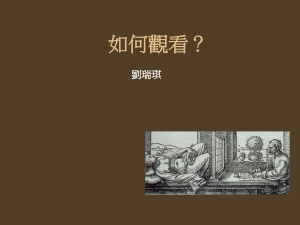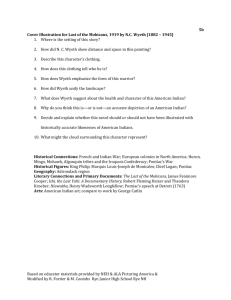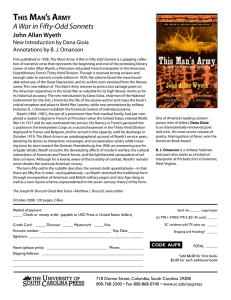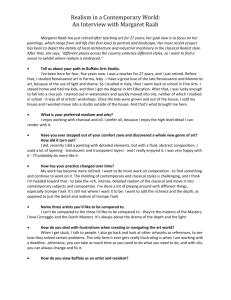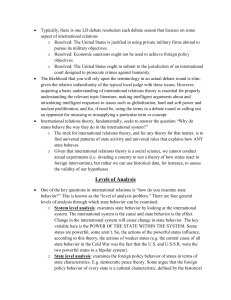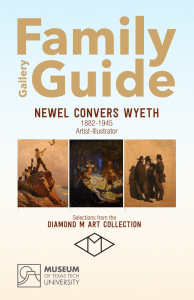An Overview of Art
advertisement
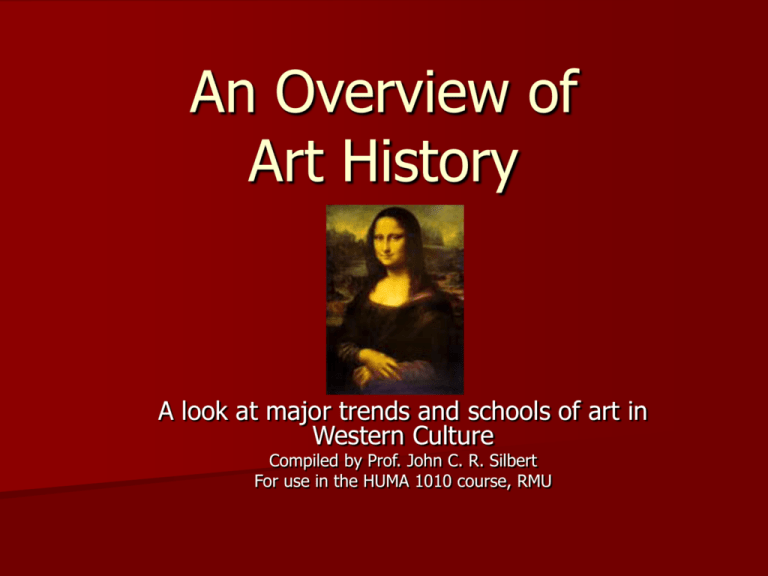
An Overview of Art History A look at major trends and schools of art in Western Culture Compiled by Prof. John C. R. Silbert For use in the HUMA 1010 course, RMU Please Note: The following slide presentation and the visuals that accompany it are intended for the sole educational purposes of HUMA 1010 academic study. As such, the material contained herein is offered under the rubric of the fair use clause of U.S. copyright law. Any other uses for this material are prohibited without the permission of the instructor and/or additional inquiry into copyrights that may be held by outside parties. -- Prof. John C. R. Silbert HUMA 1010, RMU All Visual Art is Imitation Aristotle’s word for imitation is “mimesis”; what the actor sought to do; to reveal the truth of human beings. Art as Imitation does this in two essential ways: – Art as Likeness: Rembrandt Van Rijn (top right) – “The Jewish Bride,” 1667 – Art as Alteration: Wassily Kandinsky (bottom right) – “Composition VIII,” 1923 Within each essential form there are any number of styles. Some seek to paint what is there to be painted, while others seek to paint what is in the artist’s mind (and heart). Classical Art: Art as Likeness Temple of Artemis in Ephesus Roman tile portrait Grecian Urn Sarcophagus of woman and dog; Late Roman Classical Art -- quick facts: Classical art is noted for its strong sense of form, proportion and balance. Much of the art and architecture served the needs of the state. Classical art at first sought to idealize the human form; reaching for perfection (as the gods/goddesses were perfect). Note the sculpture on p. 147 in TABH. Much of the art of the Greek period was attributed to Phidias, a painter, sculptor and architect greatly admired in the 5th cy B.C.E. In the late 4th cy B.C.E., the emphasis shifted towards realism; with less depictions of idealized forms replaced by more life-like human qualities. Note the sculpture on p. 149 in TABH. Roman Art often depicted less serene, more dynamic forms that appealed to human passions. Euclid’s “Golden Section” This is a mathematical calculation of balance that states the most pleasing relationship between two connecting parts is such that the smaller is to the larger as the larger is to the sum of the two. It is expressed mathematically as a ratio of 1:1.68. The golden section finds its way into architecture and painting in the classical and subsequent art periods. Leonardo da Vinci was so impressed by this principle that he called it the “Divine Proportion.” The Parthenon, Acropolis, Greece Euclid’s Golden Section in Architecture A B C The Golden Section: the smaller is to the larger as the larger is to the sum of the two -- BC is to AB as AB is to AC. Slide reference from http://ccins.camosun.bc.ca/~jbritton/goldslide/jbgoldslide.htm Leonardo’s “Annunciation of the Virgin” Divide this painting into a square on the left and another on the right. (If it is a root-5 rectangle, these lines mark out two golden-section rectangles as the parts remaining after a square has been removed). Also mark in the lines across the picture which are 0·618 of the way up and 0·618 of the way down it. Also mark in the vertical lines which are 0·618 of the way along from both ends. You will see that these lines mark out significant parts of the picture or go through important objects. You can then try marking lines that divide these parts into their golden sections too. Reference from -http://www.mcs.surrey.ac.uk/Personal/R.Knott/Fibonacci/fibInArt.html#daVinci Byzantine Art Icon of Madonna and Child Bust of Emperor Constantine Byzantine and Medieval Art For nearly a 1000 years, the art world came under the influence of the Christian church. (5th cy C.E. to 15th cy C.E.). Beginning with Emperor Constantine’s conversion to Christianity, the church began a strong cultural mandate in Western culture. The goal of art was to remind people of Jesus Christ, the saints and apostles and the story contained in Holy Scriptures. Depictions of Christ showed his wisdom and depth (a more adult-like face even when showing him as a child.) The Pagan world of classical art was frowned upon. Medieval Art Detail of stained glass; St. Peter with Keys Cathedral Carving Poitiers, France From the cathedral at Chartres, France Medieval Art Gargoyle; York Minster Cathedral The Nave of York Minster The Renaissance “Mona Lisa” ( aka, La Gioconda) wood panel Leonardo da Vinci; 1503-1506 “Renaissance” means “rebirth.” This period was known for its flowering in the arts, music and literature. Increasing emphasis was placed on essential human qualities and on freedom and individuality. The three great art figures of this period are Leonardo da Vinci, Michelangelo, and Raphael. “The Last Supper,” 1498 fresco Leonardo da Vinci; Painted in the Convent of Santa Maria delle Grazie, Milan Michelangelo “David,” St. Peter’s, Rome “The Pieta,” St. Peter’s Rome Details of panels from Michelangelo’s painting of the Sistine Chapel showing the Creation of Adam (top) and Eve (right). Raphael Sanzio “School of Athens,” 1510 Rembrandt van Rijn “The Jewish Bride,” 1667 The greatest of “The Dutch Masters,” Rembrandt perfected art as realism and the use of chiaroscura. “The Return of the Prodigal,” 1669 Goya “The Shootings of May Third,” 1814 Goya represents an early turning in art from realism (as likeness), to art as alteration. Many of his works were expressive of an inner vision and commentary about the times in which he lived. “The Puppet,” 1791 The Advent of Photography and the end of the dominance of realism Above: 31st PA Regiment Soldier’s Family visits on the battlefield (1861-65); Upper Right: Abraham Lincoln c. 1860; Lower Right: Union Dead at Gettysburg, July 1863 Impressionism “The Waitress,” 1877 Eduard Manet Sought to focus on the way light is perceived by the human eye. This period inaugurates art as alteration. Imitation in art is within the painter. “Madame Monet and her Son,” 1875 Claude Monet “The Child’s Bath,” 1893 Mary Cassatt Post-Impressionism Vincent Van Gogh “Fifteen Sunflowers in a Vase,” 1888 “Self-Portrait with Bandaged Ear,” 1889 Pointilism “Le Pont de Courbevoie,” 1886-1887, by Georges Seurat The 1913 69th Regiment Armory Exhibition Named for the building in New York City where this art exhibition took place. Brought to the U.S. many of the new modern artists who were launching into art as alteration with boldness and intensity. This art exhibition found few admirers at the time due to its radical departures from traditional painting. Unlike Van Gogh (and others in Post-impressionist alteration) who began with the natural world and painted it as they saw it, alteration for these modern artists sought to impose something new on the world, something inside themselves. Abstractionism “Composition VIII,” 1923, Vasiliy Kandinsky “Arearea” (Joyousness), 1892, by Paul Gauguin Cubism “Les Demoiselles d’Avignon,” 1902, By Pablo Picasso “Guitar and Violin,” c. 1912 By Pablo Picasso “Guernica,” 1937; By Pablo Picasso “Bottle and Fishes,” 1910; By Georges Braque Surrealism A style of painting that has recognizable figures and shapes but these things are related to each other as objects in dreamlike state. “The Persistence of Memory,” 1931 By Salvador Dali “The Last Supper,” 1955, By Salvador Dali Georgia O’Keefe “Iris,” 1929 “Series 1, Number 8,” 1919 “Red and Orange Hills,” 1938-1939 Modern Realism “Nighthawks,” 1942, By Edward Hopper “Cape Cod Afternoon,” 1936 (Carnegie Museum of Art) “A Woman in the Sun,” 1961, The Whitney “Into Bondage,” 1936, Aaron Douglas “Aspects of Negro Life: From Slavery through Reconstruction,” 1934 “Ugly Americans,” by Duane Hanson Abstract Expressionism “Greyed Rainbow,” 1953, By Jackson Pollock Study for “Woman Number 1,” 1952, By Willem de Kooning Pop Art “Campbell’s Soup 1,” 1968, By Andy Warhol “Beethoven,” 1987, By Andy Warhol “Elvis,” 1964 “Soft Toilet,” 1966 By Claes Oldenburg “Knife Ship II,” 1986, By Claes Oldenburg Museum of Contemporary Art, Los Angeles “Flying Pins,” 2000, By Claes Oldenburg; Eindhoven, The Netherlands Andrew Wyeth – Prof. Silbert’s favorite artist “Spindrift,” 1950 Denounced by some art critiques as a mere “copier” – derogatory even to a realist – Wyeth comes from a long line of artists (his son Jamie) and illustrators (his father, N.C.). Wyeth once spoke of his art as radically abstract. “Christina’s World,” 1948 (Maine was one of two places of inspiration to him.). Portrait of President J. F. Kennedy, by Jamie Wyeth, c. 1967 “Braids” (Helga), 1979 Wyeth divides his time between Chadds Ford, PA and Maine. An illustration for “Treasure Island” by N. C. Wyeth, 1911 “Wind from the Sea,” 1948 Modern Architecture Frank Lloyd Wright, one of the three major architects mentioned in TABH sought to bring balance between form (art), function (use) and the environment. He pushed the notion that “form follows function;” an idea that the needs of a building’s use come first before any artifice (form) should be applied. Buildings should blend with the environment and not overwhelm it. Where necessary, a building should shield the building’s user from harsh and unattractive outside influences. To the Left: “Falling Water,” built for the private use of the Kaufmann family in Ohiopyle, PA. Frank Lloyd Wright The Guggenheim Museum, New York Built with thick walls to shut out urban noise and suffused with indirect lighting, Wright sought to create a “quiet oasis” for the viewing of other works of human creativity (modern art). Frank O. Gehry The Guggenheim Museum; Bilbao, Spain, 1997 For Gehry, form is paramount to his architectural vision; a vision that is uniquely his. There is nothing “classical” about this structure and unlike Johnson he pays no homage to earlier forms. His architectural is innovative and controversial. Philip Johnson Johnson was inspired by Gothic forms (late medieval church architecture) and re-invigorated them into new striking building designs. PPG Place; Pittsburgh, PA Bell Tower, Crystal Cathedral; Garden Grove, CA Wedding at the Crystal Cathedral As TABH says, “The world of art belongs to you.” “American Gothic,” 1930 By Grant Wood
